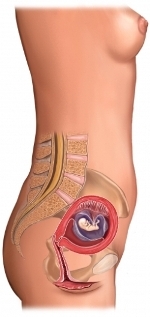Team vorsinok chorionic transtservikalynыy – Chorionic biopsy transtservikalynaya
Description chorionic villus sampling
Chorionic biopsy – test, which is made for pregnant women. It includes a selection of chorionic villi from the placenta. The placenta is an organ, which provides delivery nutrients and oxygen to the baby during pregnancy. It also removes waste from the baby's blood. Chorionic villi is the tissue, which makes up most of platsenty.Test held between 9-13 weeks of gestation.

Reasons for chorionic villus sampling
Chorionic villi contains valuable information about the child's genes. Checking chorionic villi, the doctor can find out, whether the child has a chromosomal abnormality, like syndrome Dauna.Test can also detect genetic disorders, such as cystic fibrosis. But the analysis does not detect neural tube defects, eg, Spina Bifida.
Your doctor may consider the need for chorionic villus sampling in the following cases:
- Other Tests, such, as ultrasound in the first trimester showed abnormal results;
- Previous pregnancy with a chromosomal abnormality was;
- Senior maternal age: 35 and older;
- Pregnant or her partner are carriers of a genetic disease;
- A family history of genetic disease.
Although the test result, showing a healthy baby without a genetic disorder is desirable, you need to be ready to, that the results show the opposite. If the test shows, that the child may have a genetic disorder, This may require making tough decisions, relating to pregnancy, eg, the need to interrupt.
If you plan to continue the pregnancy, you need to be ready to address the problems of the child with special needs. A doctor can help you understand the pros and cons of the test, and discuss options, chorionic villus sampling when the result is ready.
Possible complications of chorionic villus sampling
There are some risks, associated with this test:
- Miscarriage;
- Spasms;
- Bleeding from the vagina;
- Sensitive to the child's blood, which can get into the blood of a pregnant (Rh incompatibility);
- Infection in the uterus.
Chorionic villus sampling is not recommended in the following cases:
- There is an active infection, such as sexually transmitted diseases;
- Expected twins;
- Bleeding from the vagina during a previous pregnancy.
- The presence of uterine fibroids;
- The slope of the uterus.
How the transcrivical biopsy of the chorion?
Preparation for the procedure
Maybe, before the test is necessary to have a full bladder, and so drink plenty of fluids. But, whichever, both located placenta, surveyed may be asked to urinate before the test. We need to discuss with your doctor the specific ways to prepare for the test. Besides, you need to organize a trip to the procedure and back from the hospital.
Description transcervical chorionic villus sampling
The doctor will use the ultrasound, to know the position of the placenta and the baby's size. Ultrasound uses sound waves to create and send the monitor image of organs and tissues in the body.
The doctor will use the ultrasound images as a guide, to take a sample of placental tissue. The vagina and cervix is cleaned with an antiseptic. Then, to expand the entrance to the vagina, the device is used, called extender. Thin, a hollow tube is inserted through the vagina and cervix. Once it reaches the placenta, it absorbed a small sample of tissue. During the selection may feel some cramping.
After chorionic villus sampling
Your doctor may monitor your heart rate using ultrasound baby. The survey will be asked to go home and relax. Pregnant likely, be able to return to normal activities the next day.
How long will the transcrivical biopsy of the chorion take?
30-45 minutes
Will it hurt when transcervical chorionic villus sampling?
Surveyed may feel some cramping during and after the procedure. There may also be some bleeding right after the test.
Results chorionic villus sampling
Research chorionic cells may take 1-2 of the week. After receiving the results can be discussed with your doctor or genetic counselor.
If the test results are unclear, perhaps, It needs another test, called Amniocentesis. This will help narrow the results.
If the results show, that the child has a genetic disorder or problems with chromosomes, It will be further negotiated during pregnancy. This can be a stressful time. You may need the support of family, friends, and health care workers.
Contact your doctor after chorionic villus sampling
After returning home, you need to see a doctor, If the following symptoms:
- Heavy bleeding from the vagina;
- Leaking of amniotic fluid;
- Uterine contractions;
- Fever;
- Chills.
